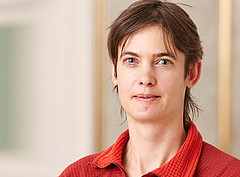€10 million | ERC Synergy Grant
Pioneering Research in Hohenheim [13.11.20]

Prof. Dr. Waltraud Schulze. Picture: University of Hohenheim / Jan Winkler
In her free time she can claim the first ascent of three 6000m peaks in the highlands of Tibet and when cycling on different continents she can cope with extreme temperatures between minus 40 and plus 50 degrees.
Prof. Dr. Waltraud Schulze feels the same passionate urge for discovery when it comes to understanding the inner life of plants. Her approach is systems biology: a discipline that combines mathematical and analytical methods from bioinformatics with experimental approaches.
For several years now, her department has been one of the strongest in terms of third-party funding at the University of Hohenheim. Step by step, Schulze and her team have collected individual pieces of the jigsaw puzzle that will enable a completely new understanding of how plants distribute nutrients among their organs and how signals are passed from cell to cell.
The approval of the ECR Synergy Grant means that a breakthrough is now within reach.
10 million euros for pioneering work
The ECR Synergy Grant is the highest endowed program of the European Research Council with 10 million euros. It is intended to enable research teams of 2-4 members to carry out visionary research in the frontier areas of knowledge - without any concrete application. The excellence of the project idea and the researchers are equally important in the selection process. Out of 441 submitted proposals, only 34 will be funded in Europe in 2020.
On the phone, Waltraud Schulze's delight can be heard: "Of course it makes you proud when you can convince the decision-makers of an idea that you have been working on for almost two years on the side among such a broad range of applicants. But above all, I am overjoyed that I can now offer my team at the department job security for 6 years. From April 2021, we will be able to go full throttle and do pioneering work together in a highly exciting field of plant biology."
One of the first people to congratulate me was the Vice President for Research at Hohenheim, Prof. Dr. Julia Fritz-Steuber:
"With the success of the ERC Synergy Grant, Ms. Schulze and her project partners now belong absolutely to the European research elite. When a Hohenheim researcher wins in such a competitive environment, it naturally also increases our reputation as a research location as a whole. At the same time, I am pleased that the University, together with the Gips-Schüle Foundation, was able to support the preparatory work for the successful application by awarding the 'Freedom for Research' prize in 2018."
The Hohenheim Research Prize is endowed with €150,000 and is awarded once a year. It is intended to support scientists in initiating applications for larger collaborative projects.
Focus on cell-cell connections
In concrete terms, the now approved ERC Synergy Grant project deals with cell-cell connections of plants, the so-called plasmodesmata - fascinating structures that were first described and named 140 years ago. However, their composition and function is still largely unknown, as they still elude conventional research methods. With a diameter of between 50 and 160 nanometers, the channels are too small for optical microscopes, but too large for classical electron microscopes.
"Plasmodesmata play an important role, for example, when photosynthetic products are distributed in the plant from the leaf, and they are essential in controlling developmental processes such as flower formation or the formation of root hairs," explained Prof. Dr. Schulze. "Understanding how they function is therefore a particularly important component in understanding how yields are produced or how the plant integrates developmental signals and information from the environment. Plant viruses also use plasmodesmata to spread from one cell to another".
Four research teams pulling together
In order to investigate the tiny channels between the cells, four research groups have joined forces under the name SymPore ("Plasmodesmata as Symplasmic Pores for Plant Cell-to-Cell Communication") and intend to decipher the structure, composition, and function of the plasmodesmata in close cooperation over the next 6 years, using a combination of different high-end methods.
The working group around Prof. Dr. Waltraud Schulze will receive about € 2.64 million to identify the "components" of the plasmodesmata. These include proteins and lipids. The exact components that make up the plasmodesmata are still largely unknown, and their role in the function of the channels is unclear. "In order to understand the structure and function of the plasmodesmata, it is therefore first of all important to know what proteins and lipids are involved and how they interact with each other," said Prof. Dr. Schulze.
At the HHU, Prof. Dr. Rüdiger Simon's research groups are concentrating on creating a blueprint of where the components of the plasmodesmata are located in space and time. Prof. Dr. Wolf B. Frommer, the spokesman of the group, is using sophisticated biosensor technology to develop new methods to visualize the function of plasmodesmata in living plants.
Prof. Dr. Wolfgang Baumeister and his team at the MPIB in Martinsried are world leaders in the elucidation of complex structures with highest resolution - down to single molecules - by cryoelectron tomography. The latest methods developed by Prof. Dr. Baumeister are now expected to achieve a breakthrough in this field and thus help to obtain an overall structural picture of the plasmodesmata.